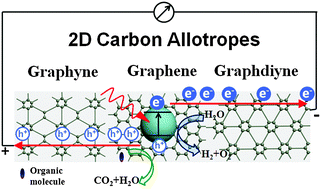Two-dimensional carbon leading to new photoconversion processes
Abstract
Two-dimensional (2D) carbon allotropes, which are atomic thick layers made of network carbon atoms with hexagonal structured lattices, have been neglected until the direct investigation of mechanically exfoliated graphene by Novoselov et al. in 2004. Graphene is a 2D carbon allotrope with a unique structure of hexagonally arranged atoms that give it unparalleled electrical conductivity and carrier mobility, in addition to excellent mechanical flexibility and extremely high specific surface area. Graphene and its derivatives have been extensively studied for photovoltaic and photocatalytic applications due to their inherent nature to extract and transport charges from photon-absorbing semiconductors and conjugated polymers. Graphyne and graphdiyne, 2D carbon allotropes like graphene but containing not only doubly but also triply bonded carbon atoms, are predicted to possess intrinsic semiconductor bandgap and even more superior electrical properties than graphene. The current theoretical understanding and experimental status of graphyne and graphdiyne will be discussed in contrast of graphene, demonstrating those promising competitors to graphene in further lightening a new photoconversion. This review addresses the recent successes and current challenges of graphene, graphyne and graphdiyne, and provides insightful perspectives for the future applications of 2D carbon materials in photoelectric conversion and photocatalysis.


 Please wait while we load your content...
Please wait while we load your content...